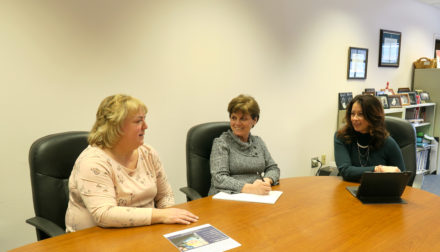Children’s well-being is the primary goal

Christine Peters

L-R Foster Care/Adoption Supervisor Paula Dew, Home Finder Lorene Easter, Director of Clinton County’s Legal and Social Services Christine Peters
By John T. Ryan
Peru – Have you ever considered being a foster parent? Who are the children who need foster care? Do many foster parents adopt the children they foster? How do you become a foster parent? Christine Peters, Director of Clinton County’s Legal and Social Services, has the answers to these questions. Peters supervises five units related to foster care – Family First, Child Protective Services, Preventative, Adolescent, and Foster Care.
Parental mental health and substance abuse problems are the most common reasons local children need foster care according to Peters. In addition, generational poverty sometimes contributes to chronic neglect – children not attending school, having unmet medical needs, or living in a dirty environment. She commented, “Last year, our Child Protective Services Unit completed about 1,200 reports. Pre-pandemic, we were doing about 1,600 reports.” Peters said most child referrals come from schools, doctors, concerned citizens, family members, and law enforcement.
Children’s well-being is the primary goal of Social Services foster care professionals. Peters explained, “We look for permanency for the children at all times. For the first 12 months a child is under our supervision the goal is always reunification with the parent. We want foster care to be temporary, but we realize that can’t always happen. Ultimately, we want one home for one child.”
Social Services caseworkers maintain close contact with children and foster parents. Peters explained, “We have to see the child at least twice a month. One time it has to be in the home; the other time can be here. In the reunification phase, children meet with the parent once a week. So we see the child a minimum of two and a maximum of four times a month.”
Clinton County typically has about eighty to ninety children in foster care and twenty to twenty-three adoptions a year. Peters explained, “Right now, we have sixty-six foster/adoptive homes and eighteen relative foster homes. We have a lot of children with intensive behavioral issues. We also look for homes that will take large sibling groups. When people adopt a child, sometimes they leave the program. So we are constantly recruiting.” Foster parents receive daily board and care stipends, plus an annual clothing allowance.
Who typically becomes a foster parent? Peters said, “Often people who work in the helping professions – teachers, medical professionals, police officers, retired people. Sometimes people grew up in a home that fostered children. Others say they want to give back to the community or help children. Relatives often foster a child. A small percentage of our foster parents can’t have children; they want to build a family.”
Undoubtedly, many readers have additional questions. Fortunately, the Department of Social Services is conducting an informational meeting in just a few days. Caseworkers and one or more foster parents will impart information and answer questions. It’s on Tuesday, January 11th from 6 p.m. to 7:30 p.m. at 13 Durkee Street in Plattsburgh. Please call 518-565-3320 to confirm attendance since space will be limited to maintain COVID-19 social distancing.
Posted: January 5th, 2022 under County Government News, General News, Heathcare News, Northern NY News.
